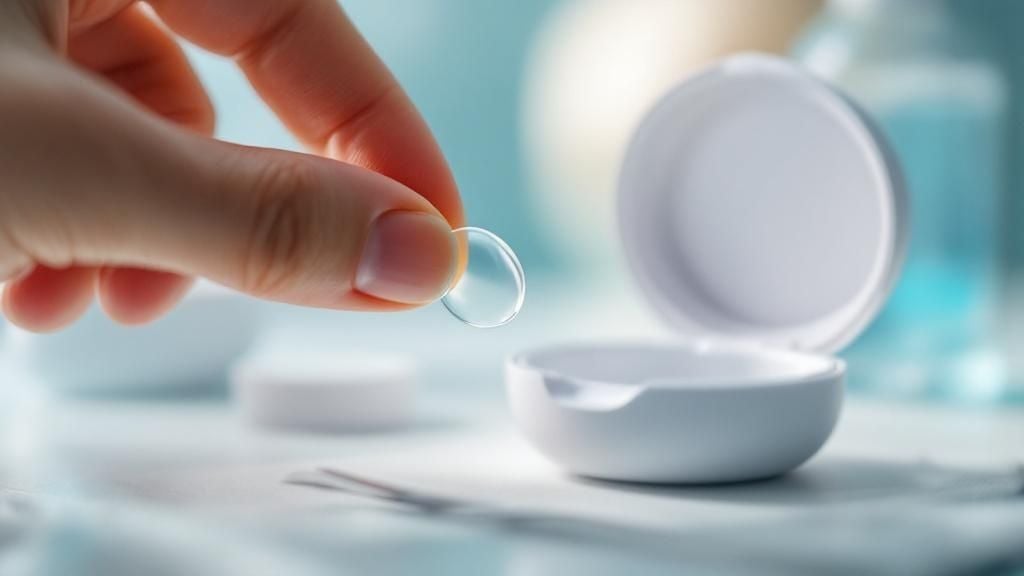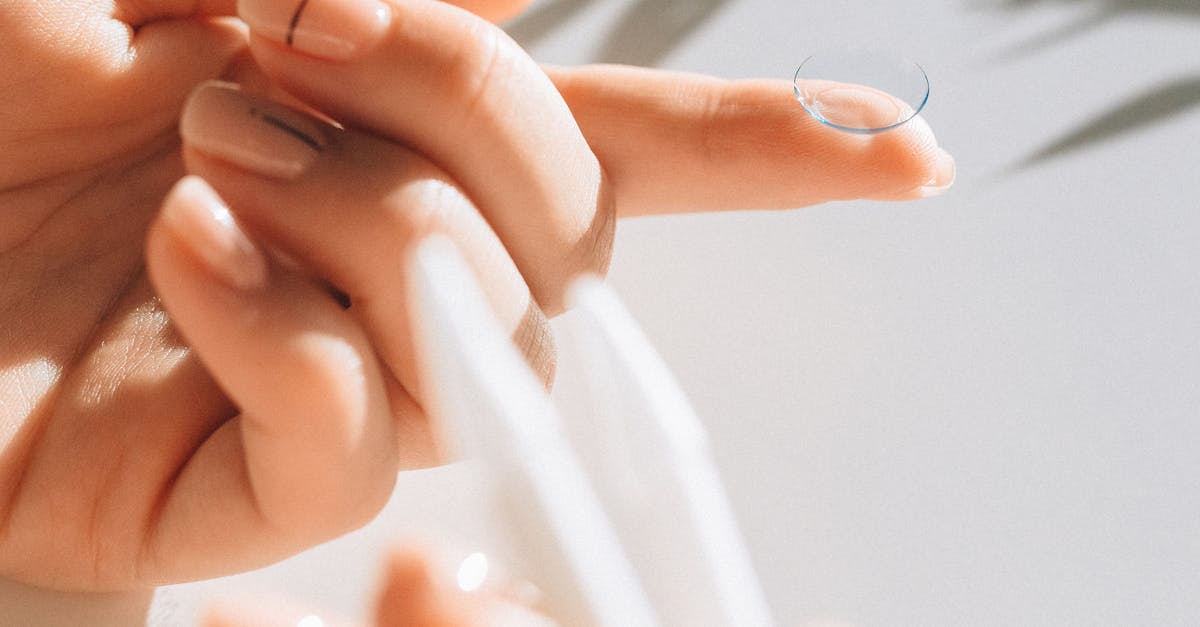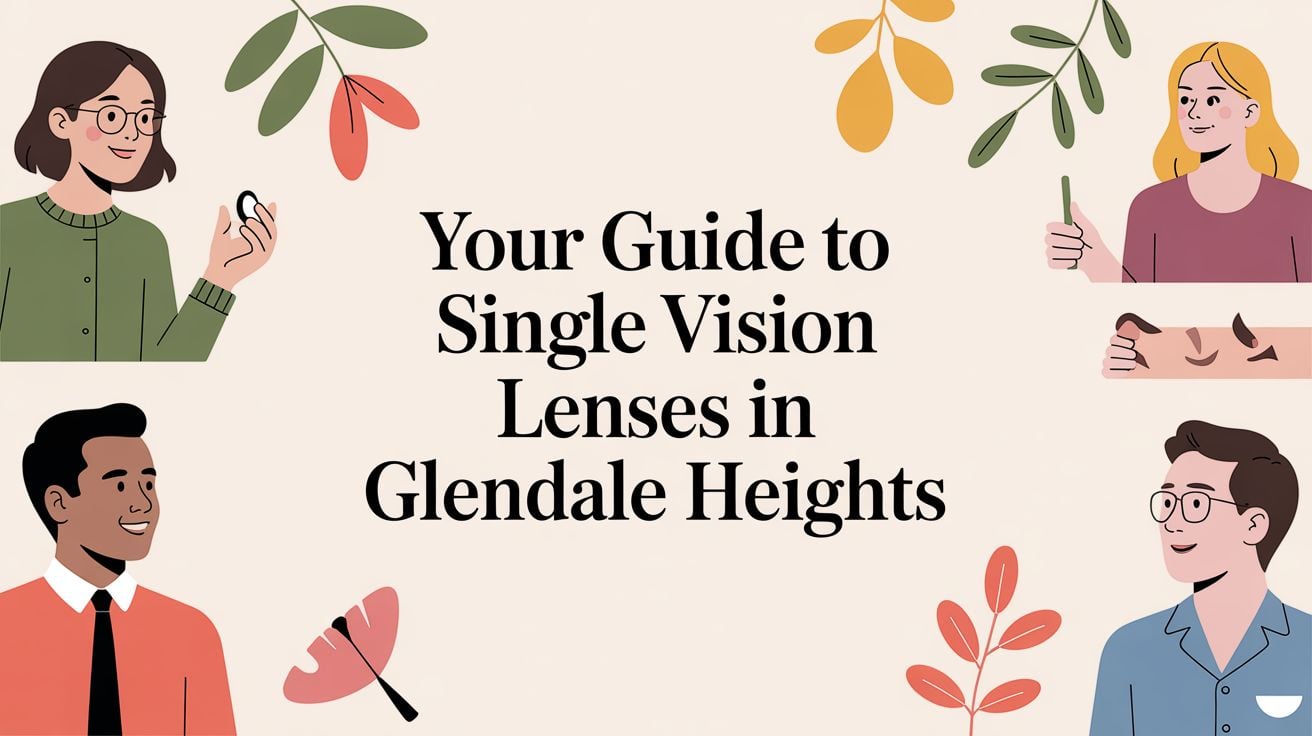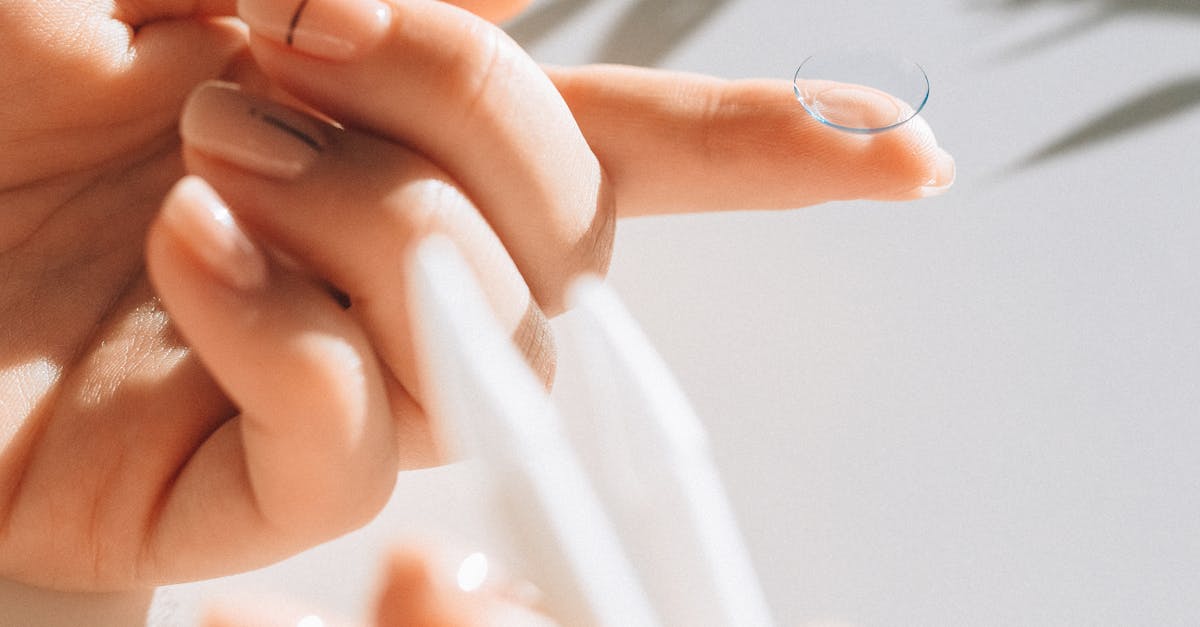Welcome to our complete guide on prescription contact lenses, brought to you by the team at iDoctor, your neighborhood optometrist right here in Glendale Heights. If you've ever been frustrated with glasses sliding down your nose or just want the freedom to see the world clearly without them, you're in the right place. Whether you're a student at Glenbard North High School or drive down North Avenue every day, think of this as your local roadmap to comfortable, confident vision.
Your Vision Journey with Contact Lenses
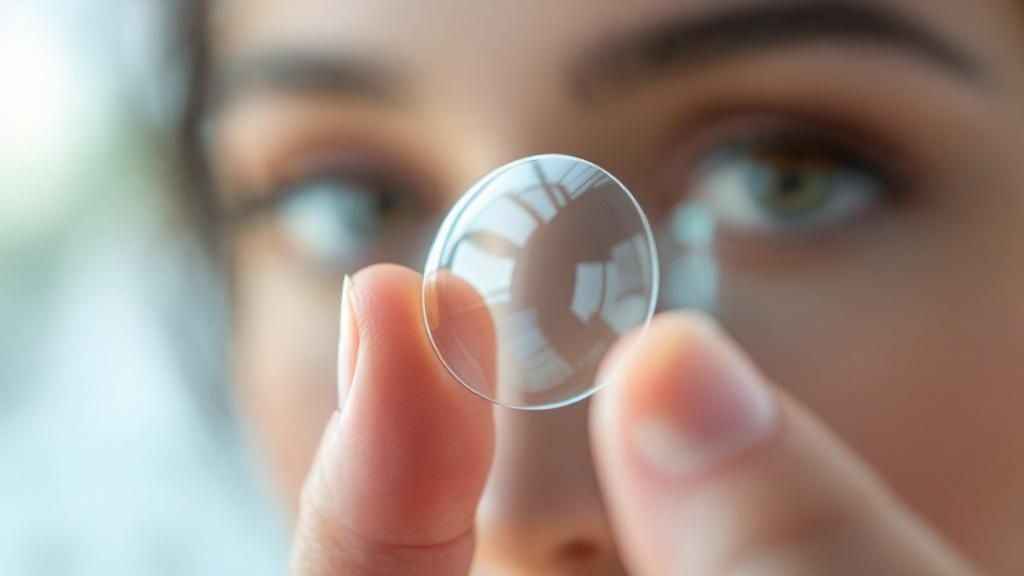
Deciding to try contact lenses is a great first step toward a new kind of visual freedom. Imagine teeing off at the Glendale Lakes Golf Club with a completely unobstructed view, or just not having to deal with foggy glasses on a cold morning. This guide will walk you through everything, from decoding your prescription to finding the perfect type of lens for your daily life in Glendale Heights.
Here at iDoctor, we know that great vision care starts with listening. Our job is to make your switch to contacts as smooth as possible.
Why Choose Prescription Contacts?
Today's contact lenses offer so much more than just clear vision. Because they sit directly on your eye, they move with it, giving you a full, natural field of view. You don't get that peripheral distortion that can sometimes happen at the edges of eyeglass lenses, which makes contacts a game-changer for anyone with an active lifestyle.
Here are a few of the biggest perks people experience when they switch:
- Unobstructed Peripheral Vision: You can see everything around you, without eyeglass frames getting in your way.
- Active Lifestyle Freedom: Play sports, hit the gym, or enjoy the outdoors without worrying about your glasses falling off or breaking.
- No Weather Worries: Forget about rain-splattered lenses or that frustrating fog that clouds your vision when you come in from the cold.
- Style Versatility: Feel free to wear any non-prescription sunglasses you like, or just enjoy a frame-free look.
At iDoctor, our goal is to match you with prescription contact lenses that don’t just correct your vision—they enhance your life. The right fit should feel so natural that you forget you’re even wearing them.
This whole journey begins with one essential step: a professional detailed eye exam in Glendale Heights. It's important to know that a contact lens prescription is different from one for glasses. It includes specific measurements of your eye's unique curvature to ensure the lens fits safely, comfortably, and correctly.
How Contact Lenses Correct Your Vision

So, how do these tiny, transparent discs actually work their magic? It's pretty amazing, really.
Think of your eye as a camera that's just a little out of focus. Prescription contact lenses are like a custom-made lens that sits directly on your eye's surface, fine-tuning its focus with incredible precision.
Glasses bend light from a small distance away, but contacts become a seamless part of your eye's optical system. Floating on your tear film, they bend light exactly where it needs to go—right onto your retina—to give you that crisp, clear picture. This is why the vision you get from contacts often feels so much more natural and expansive.
To get this right, though, the prescription has to be spot-on. It might look like a bunch of confusing numbers and letters, but each one is critical for giving you perfect vision. Knowing what they mean really highlights why a professional fitting is non-negotiable for something so personalized.
Decoding Your Contact Lens Prescription
Your contact lens prescription is more than just a set of numbers; it's the specific blueprint for your vision. While it starts with your glasses prescription, it includes extra details that are essential for a safe, comfortable fit on your eye itself.
Let's break down the key terms you’ll see in simple language.
- Sphere (SPH): This is the main lens power. A minus number (like -2.50) corrects nearsightedness, while a plus number (like +1.75) corrects farsightedness. The further from zero, the stronger your prescription.
- Base Curve (BC): Measured in millimeters, this number defines the curvature of the lens. It has to match the curve of your cornea. Too flat, and it'll slide around; too steep, and it'll feel tight.
- Diameter (DIA): This is the width of the lens from edge to edge, also in millimeters. It ensures the lens is large enough to sit properly over your cornea.
A contact lens prescription is tailored specifically to your eyes. It considers not just your vision power but the unique physical shape of your eye, which is why you can't use a glasses prescription to buy contacts.
If you have astigmatism—which just means your eye is shaped a bit more like a football than a baseball—your prescription will have two extra values: Cylinder (CYL) and Axis. The Cylinder adds the extra power needed to correct the irregular curve, and the Axis (a number from 0 to 180) tells the lens exactly where to orient that power. Think of it as putting the correction in precisely the right spot to sharpen the blur.
At iDoctor, we make sure every one of these measurements is perfect for your eyes.
Finding The Right Type Of Contact Lens For You
The world of contact lenses has expanded dramatically, and there's a solution out there for just about every vision need and lifestyle. This isn't a one-size-fits-all situation by any means. When you come in for an exam, we'll walk through all the options together to find the perfect match for your eyes.
The vast majority of people wear soft contact lenses, loved for their immediate comfort and flexibility. This chart gives you a quick snapshot of just how popular they are.
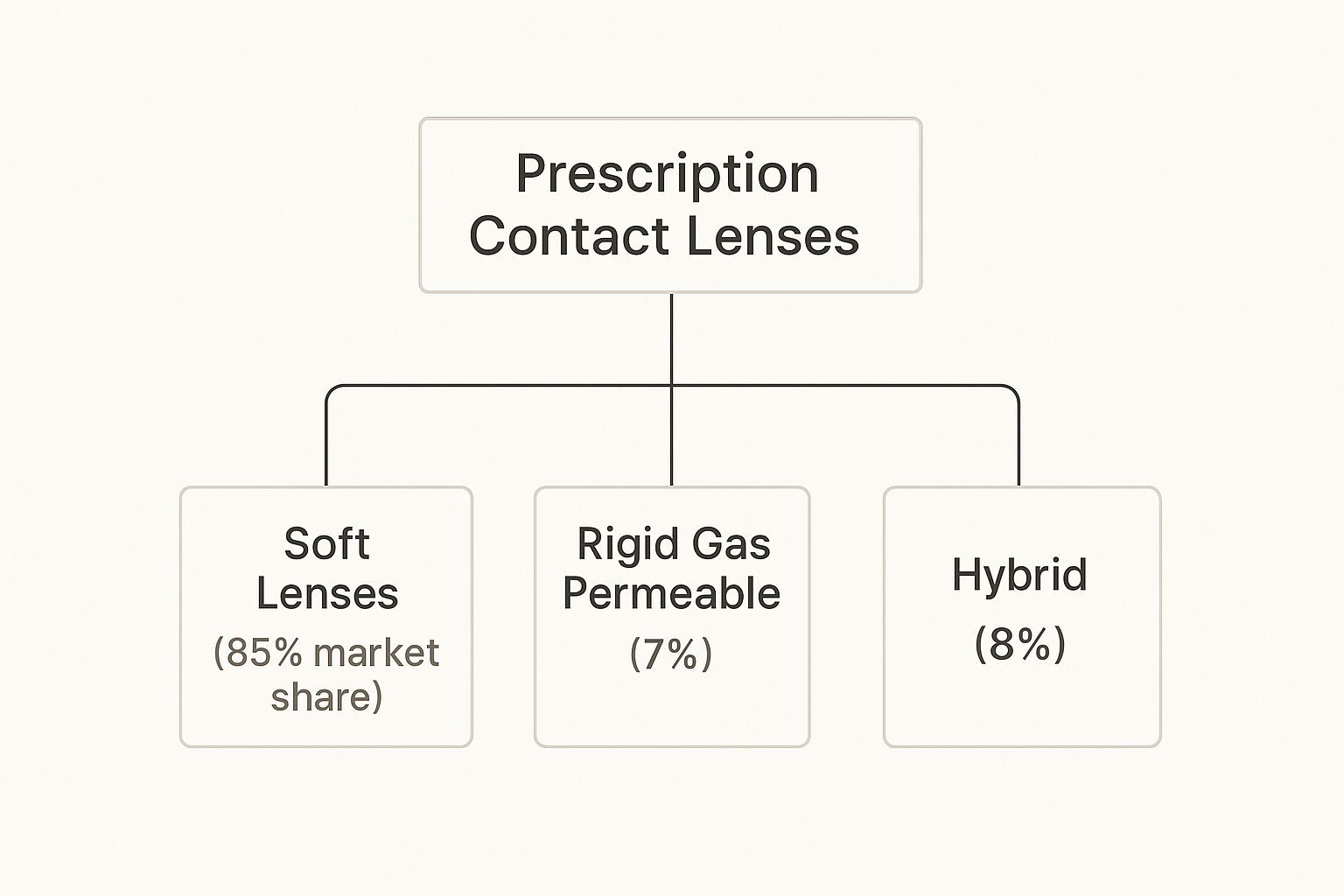
As you can see, soft lenses really own the market. That's because they're not only comfortable but also incredibly versatile, able to correct a wide range of vision issues.
Lenses For Every Vision Need
The type of prescription contact lenses you need really comes down to what your eyes need help with. It helps to think of them as different tools, each crafted for a specific job.
To make this a little clearer, here’s a breakdown of the most common lens types we work with at iDoctor.
Comparison Of Common Contact Lens Types
| Lens Type | Corrects | Best For | Key Benefit |
|---|---|---|---|
| Spherical | Nearsightedness & Farsightedness | The most common vision problems where the eye is uniformly shaped. | Simple, straightforward correction with one power across the whole lens. |
| Toric | Astigmatism | Individuals whose cornea is shaped more like a football than a sphere. | Specially weighted to stay in place, ensuring clear and stable vision. |
| Multifocal | Presbyopia (age-related farsightedness) | People who need help seeing clearly at near, intermediate, and far distances. | Eliminates the need for reading glasses over your contacts. |
Each of these lenses is engineered to solve a unique vision challenge, ensuring you get the sharp, reliable sight you deserve.
Finding the right lens isn't just about clear vision; it's about all-day comfort. Your lifestyle, eye health, and prescription all play a role in making the perfect choice.
Advanced Materials For Enhanced Comfort
Beyond just the type of correction, the material the lens is made from is a huge factor in comfort and overall eye health. Thankfully, the technology here has made some incredible leaps.
For instance, many lenses have moved on from basic hydrogel materials to advanced silicone hydrogel. These newer materials allow up to five times more oxygen to reach your cornea compared to older options.
Why does that matter? More oxygen means happier, healthier eyes. It dramatically boosts comfort and reduces the risk of problems like dry eye and infections, letting you wear your lenses comfortably for longer.
Choosing the right lens is a team effort. During your appointment, we’ll consider all these factors to ensure you get the best possible result. You can learn more about this process by reading our guide on the importance of a professional contact lens fitting in Glendale Heights. Together, we'll navigate the options to find lenses that feel as good as they see.
Why a Professional Lens Fitting Is So Important
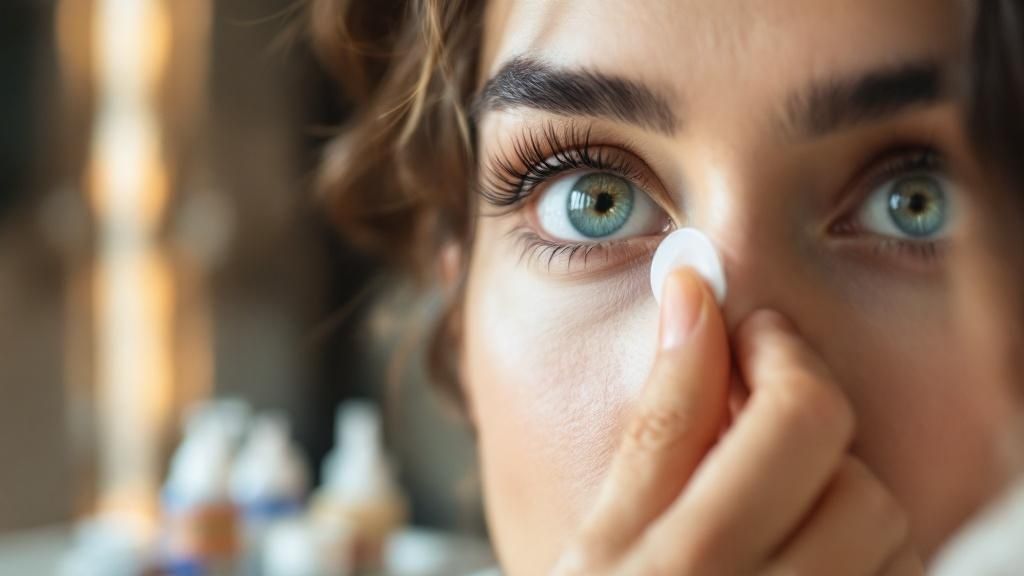
It’s a common mistake to think your glasses prescription is all you need to order contact lenses. But the truth is, they're two completely different measurements.
Think of it this way: your glasses prescription is like knowing your T-shirt size—a good starting point. A contact lens fitting, on the other hand, is like getting a suit custom-tailored. It has to fit you and you alone.
Getting this fit right isn't just about comfort; it's a matter of eye health. Since a contact lens rests directly on the delicate surface of your cornea, it has to match your eye's unique shape perfectly. An ill-fitting lens can cause everything from nagging irritation and blurry vision to more serious health issues down the road.
This is why a specialized fitting is a cornerstone of the care we provide at iDoctor. We want to make sure your vision is not only clear but also completely safe.
It's More Than Just the Numbers
A professional contact lens fitting goes way beyond the simple numbers on your glasses prescription. It’s a separate, focused appointment where we take precise measurements to find the ideal lens for your specific eyes.
Here’s a look at what our comprehensive fitting process involves:
- Mapping Your Cornea: We use a keratometer to measure the exact curve of your cornea. This gives us the right Base Curve (BC), ensuring the lens sits smoothly on your eye without being too tight or too loose.
- Finding the Right Size: We measure the size of your pupil and iris to determine the correct lens Diameter (DIA). This is key for making sure the lens is centered properly and covers the right area.
- Checking for Dryness: Healthy eyes depend on a stable tear film. We’ll evaluate yours to see if dryness might be an issue, which helps us recommend lens materials designed to retain moisture and keep you comfortable all day.
A proper contact lens fitting is where clinical science meets personalized care. We analyze the unique architecture of your eyes to ensure the lenses you wear are not just effective, but also healthy and comfortable for all-day use.
There’s no doubt about the popularity of contact lenses. In fact, North America is the largest market in the world, with an estimated 46 million users in the United States alone as of 2022. This widespread use is supported by strong safety standards from bodies like the U.S. FDA, which classifies contacts as medical devices. That alone highlights just how crucial a professional fitting is for safe wear.
Ultimately, our goal is to make your move to contact lenses seamless and safe. Find out how we tailor our approach during a professional contact lens fitting in Glendale Heights. It's the essential step to protecting your vision and enjoying the freedom contacts offer, without compromise.
Healthy Habits for Comfortable Lens Wear
Think of your prescription contact lenses like high-performance gear for your eyes. And just like any specialized equipment, a little bit of maintenance goes a long way. The single most important thing you can do for comfortable, clear vision is to lock in a simple daily hygiene routine.
This isn't just about following rules; it's about protecting your eyesight for the long haul. The habits you form now are what will keep your lenses feeling great all day, every day.
Your Daily Lens Care Checklist
Getting the hang of daily lens care is actually quite simple. It all starts with clean hands and the right cleaning solution—and never, ever anything else.
Here’s a quick step-by-step to keep your lenses in top shape:
- Wash Your Hands Thoroughly: Before you even think about touching your lenses, wash your hands with soap and water. Dry them with a lint-free towel to avoid getting tiny fuzzies stuck on your lens (or in your eye!).
- Clean One Lens at a Time: Put one lens in the clean, dry palm of your hand. Squeeze a few drops of fresh solution onto it and gently rub the lens with your fingertip. This little step physically removes the daily buildup of proteins and debris.
- Rinse and Store: Give the lens a good rinse with more fresh solution to wash everything away. Then, pop it into a clean lens case and fill it up with new solution.
- Repeat for the Other Eye: Now, just do the exact same thing for the other lens. Easy as that.
Making this a non-negotiable part of your daily routine is your best defense against irritation and nasty infections.
Common Mistakes to Avoid
Even people who've worn contacts for years can slip into bad habits. These common shortcuts might seem harmless, but they can seriously mess with your comfort and, more importantly, your eye health.
Your eyes are one of the most sensitive parts of your body. Using anything other than sterile, approved contact lens solution—especially tap water—can introduce harmful microorganisms that may lead to serious infections.
Here are a few critical things to never do:
- Never Use Tap Water: This is a big one. Tap water, bottled water, and even saliva contain bacteria and nasty little organisms that can cause severe, sometimes sight-threatening, eye infections. Stick to sterile solution, always.
- Don't "Top Off" Old Solution: Think of it like washing your clothes in yesterday's dirty water—it just doesn't work. Old solution loses its disinfecting power and becomes a swamp for germs. Dump the old stuff out and use fresh solution every single time.
- Avoid Over-Wearing Your Lenses: Follow the replacement schedule your doctor gave you, whether it's daily, bi-weekly, or monthly. Stretching your lenses past their due date cuts off oxygen to your cornea and dramatically increases your risk of infection.
If you find yourself dealing with dryness or irritation, pushing your lenses past their limits isn't the answer. It’s better to figure out what's causing it. For more on this, you can check out our guide on the best contact lenses for dry eyes we offer right here at our Glendale Heights practice.
Your Partner in Vision Health in Glendale Heights
Choosing the right prescription contact lenses is a big decision, but it's only half the battle. The other half? Finding an optometrist who truly understands you and your eyes. At iDoctor, we bring together top-tier clinical expertise with a personal, boutique experience. It’s why so many of our neighbors consider us the best optometrist in Glendale Heights for their vision needs.
It all starts with our signature detailed eye exams in Glendale Heights. We don't do rushed, in-and-out appointments here. We set aside a full 30 minutes just for you, using advanced, high-resolution imaging to get an incredibly precise map of your eyes. This meticulous approach is key to a perfect contact lens fitting—one that delivers sharp vision while protecting your long-term eye health. It’s the difference between an off-the-rack solution and something genuinely made for you.
Premium Brands and Personalized Care
Quality and choice are non-negotiable for us. Our team will walk you through our handpicked selection of premium contact lens brands, helping you find the perfect fit for your lifestyle. Whether you need the convenience of daily disposables or specialized toric lenses for astigmatism, we’ve got you covered.
And to make things simple, we accept all major vision insurance plans. We’ll help you navigate your benefits to make sure you get the most out of them.
More and more people are discovering the freedom that contact lenses offer. In fact, the global market for prescription contacts was valued at around $14.18 billion in 2024 and is only expected to grow. This just goes to show how many people are looking for the kind of clarity and convenience you can get with the right pair of lenses. You can dive deeper into these trends over at Data Bridge Market Research.
Even the most dedicated contact lens wearer needs a great pair of glasses. For those days you want to give your eyes a break, we have a stunning, curated collection of designer eyeglasses in Glendale Heights. You can explore timeless styles from iconic brands like Cartier, Gucci, and Tom Ford, alongside accessible luxury brands like Ray-Ban and Coach, right here in our boutique.
Local FAQ: Contact Lenses in Glendale Heights
Do you offer contact lenses for astigmatism at your Glendale Heights location?
Absolutely. We specialize in fitting all kinds of lenses, including the toric lenses designed specifically to correct astigmatism. Our detailed eye exams ensure we find the perfect lens to give you clear, stable vision, no matter what your prescription is.
How do I use my vision insurance for contact lenses at iDoctor?
It's simple! We accept all major vision insurance plans. Our team will handle the heavy lifting by checking your benefits and explaining your coverage for both your eye exam and your annual supply of contacts. We want to make sure you get the most value from your plan right here in Glendale Heights.
Can I pick up my contact lens order at your Glendale Heights office?
Yes, you can. We can have your annual supply of prescription contact lenses delivered directly to our office for convenient pickup. We will notify you as soon as they arrive.
Ready to experience the freedom and sharp vision that contacts can offer? At iDoctor, your local eye doctor in Glendale Heights, we pair expert eye care with a truly personal touch to find the lenses that are just right for you. It all starts with scheduling your comprehensive eye exam.

